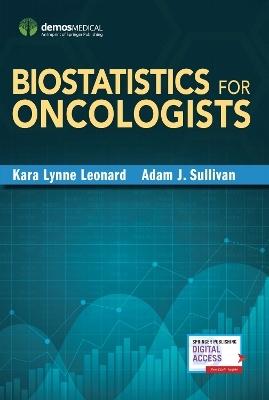
Biostatistics for Oncologists
Springer Publishing Co Inc (Verlag)
978-0-8261-6858-0 (ISBN)
Biostatistics for Oncologists is the first practical guide providing the essential biostatistical concepts, oncology-specific examples, and applicable problem sets for medical oncologists, radiation oncologists, and surgical oncologists. In addition, it serves as a review for medical oncology and radiation oncology residents or fellows preparing for in-service and board exams. All examples are relevant to oncology and demonstrate how to apply core conceptual knowledge and applicable methods related to hypothesis testing, correlation and regression, categorical data analysis and survival analysis to the field of oncology. The book also provides guidance on the fundamentals of study design and analysis.
Written for oncologists by oncologists, this practical text demystifies challenging statistical concepts and provides concise direction on how to interpret, analyze, and critique data in oncology publications, as well as how to apply statistical knowledge to understanding, designing, and analyzing clinical trials. With practical problem sets and twenty-five multiple choice practice questions with answers, the book is an indispensable review for anyone preparing for in-service exams, boards, MOC, or looking to hone a lifelong skill.
Key Features:
Practically explains biostatistics concepts important for passing the hematology, medical oncology, and radiation oncology boards and MOC exams
Provides guidance on how to read, understand, and critique data in oncology publications
Gives relevant examples that are important for analyzing data in oncology, including the design and analysis of clinical trials
Tests your comprehension of key biostatistical concepts with problem sets at the end of each section and a final section devoted to board-style multiple choice questions and answers
Includes digital access to the eBook
Kara-Lynne Leonard, MD, MS, Assistant Professor of Radiation Oncology, Alpert Medical School of Brown University, Providence, RI Adam Sullivan, PhD is Assistant Professor of Biostatistics, Alpert Medical School of Brown University, Providence, RI
I. General Statistical Concepts
1. Why study biostatistics?
1.1 What is biostatistics?
1.2 How is biostatistics useful for oncologists
2. Summarizing and Graphing Data
2.1 Types of data
2.1.1 Quantitative data
2.1.1.1 Discrete data
2.1.1.2 Continuous data
2.1.2 Qualitative data
2.1.2.1 Nominal data
2.1.2.2 Ordinal categorical data
2.2 Data summaries
2.2.1 Measures of Central Tendency
2.2.1.1 Mean
2.2.1.2 Median
2.2.1.3 Mode
2.2.2 Measures of Dispersion
2.2.2.1 Standard deviation
2.2.2.2 Interquartile range
2.3 Statistical Graphs
2.3.1 Histogram
2.3.2 Box Plot
2.3.3 Scatter plot
3. Sampling
3.1 Populations and Sample
3.2 Simple Random Sample
3.3 Other Sampling Methods
4. Statistical Estimation
4.1 Some basic distributions
4.1.1 Normal distribution
4.1.1.1 Central limit theorem
4.1.1.2 Student’s T-distribution
4.1.1.3 Standard error of the mean
4.1.2 Binomial distribution
4.1.3 Poisson distribution
4.2 Estimations
4.2.1 Point estimates
4.2.2 Confidence intervals
II. Important Statistical Concept for Oncologists
5. Hypothesis testing
5.1 Type I & Type II Errors
5.1.1 Type I Error
5.1.2 Type II Error
5.1.3 Alpha (α)
5.1.4 Beta (β)
5.2 p-values
5.3 T-Tests
5.3.1 One-Tailed versus Two-Tailed
5.3.2 Independent Samples
5.3.3 Paired Data
5.4 Wilcoxon Tests
5.4.1 Wilcoxon Rank Sum Test
5.4.2 Wilcoxon Signed-Rank Test
5.5 Analysis of Variance (ANOVA)
5.6 Testing Binomial Proportions
5.7 Confidence Intervals and Hypothesis Tests: How are they related?
5.8 Sensitivity and Specificity
5.8.1 Negative Predictive Value
5.8.2 Positive Predictive Value
5.8.3 Positive Likelihood Ratio
5.8.4 Negative Likelihood Ratio
6. Correlation and Regression
6.1 Correlation
6.1.1 Pearson’s Correlation Coefficient
6.1.2 Spearman Rank Correlation
6.2 Regression
6.2.1 Simple Linear Regression
6.2.2 Multiple Linear Regression
6.2.3 Logistic Regression
7. Categorical Data Analysis
7.1 Contingency Tables
7.1.1 2 x 2 Tables
7.1.2 RxC Tables
7.1.3 Fisher’s Exact Test
7.1.4 Chi-Square Test
7.1.5 Chi-Square Test versus Logistic Regression
7.2 Effect Size Estimators
7.2.1 Relative Risk
7.2.2 Odds Ratio
7.2.3 Relative Risk versus Odds Ratio
7.3 McNemar’s Test
7.4 Mantel-Haenszel Method
7.4.1 Homogeneity Test
7.4.2 Summary Odds Ratio
8. Survival Analysis Methods
8.1 Time-to-event Data
8.2 Kaplan-Meier Curves
8.3 Log-Rank Test
8.4 Wilcoxon Rank Sum Test
8.5 Cox Proportional Hazards Model
9. Guide to choosing the appropriate statistical test
10. Non-inferiority Analysis
III. Basics of Epidemiology
11. Study Designs
11.1 Experimental Studies
11.1.1 Clinical Trials
11.1.1.1 Common Outcomes for Clinical Trials in Oncology
11.1.1.2 Phase I Clinical Trials
11.1.1.3 Phase II Clinical Trials
11.1.1.4 Phase III Clinical Trials
11.1.1.5 Phase IV Clinical Trials
11.1.1.6 Meta-analysis
11.1.2 Field Trials
11.1.3 Community Intervention Trials
11.2 Non-experimental Studies
11.2.1 Cohort Studies
11.2.2 Case-Control Studies
11.2.3 Cohort Studies versus Case-Control Studies
11.2.4 Cross-Sectional Studies
11.2.5 Matched Studies
11.3 Analysis of Studies
11.3.1 Crude Analysis
11.3.2 Bias
11.3.2.1 Selection Bias
11.3.2.2 Measurement Bias
11.3.3 Confounding
11.3.4 Stratified Analysis
11.3.5 Effect Modification
11.4 Connections to Regression
11.5 Sample Size
| Erscheinungsdatum | 12.06.2018 |
|---|---|
| Zusatzinfo | 25 Illustrations |
| Verlagsort | New York |
| Sprache | englisch |
| Maße | 152 x 229 mm |
| Gewicht | 113 g |
| Themenwelt | Medizin / Pharmazie ► Allgemeines / Lexika |
| Medizin / Pharmazie ► Medizinische Fachgebiete ► Onkologie | |
| Medizinische Fachgebiete ► Radiologie / Bildgebende Verfahren ► Radiologie | |
| Studium ► Querschnittsbereiche ► Epidemiologie / Med. Biometrie | |
| ISBN-10 | 0-8261-6858-2 / 0826168582 |
| ISBN-13 | 978-0-8261-6858-0 / 9780826168580 |
| Zustand | Neuware |
| Haben Sie eine Frage zum Produkt? |
aus dem Bereich


